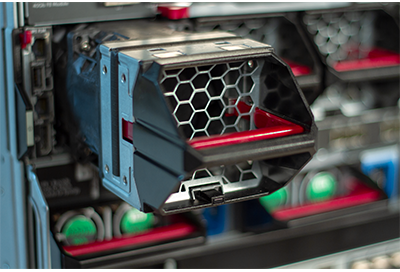Email: [email protected] Ligue agora! +55-11-3717-5537
The 10U HPE Synergy 12000 Frame provides power, cooling, management, and networking. Several different supported Synergy compute and storage modules provide the compute, memory, and storage. Supported configurations include up to 12 half-height, 6 full-height, and half-height double-wide, with configurations that also include a combination of these modules depending on your networking needs. HPE’s OneView software gathers all the hardware resources, each of which supports an integrated Lights Out module, as virtual assets that can then be distributed to accommodate specific workloads—very rapidly. This system is also highly redundant ensuring high-availability of system resources. The composability of the system refers to how the virtual assets can be easily assembled to support other workloads, or quickly allocated to support other applications or environments. Single Frame configurations may be used for Development and Proof co Concept (POC) environments but are not supported for use in Production environments. Production environments require a minimum of three Synergy frames with two Synergy Composers and two Synergy Image Streamers. Three frames is considered a minimal configuration and requires two Interconnect Modules, two Transceivers, and four cables for operation.

Performance on this system is provided by the supported Synergy Compute modules and include the dual-socket HPE Synergy 480 Compute Module, and the four-socket Synergy 660 Compute Module. Both Gen9 and Gen10 platforms are supported. The compute modules provide the compute and memory for processing. Two appliance sockets on the front left side of the HPE 12000 Frame chassis can be outfitted with either two Composer Modules with the second used for redundancy, or you can add a single Image Steamer. The Synergy Composer is outfitted with OneView software and provides the tools to gather the physical hardware information through the iLO module on each compute node (network configuration, shared/data storage configuration, firmware version, and firmware configuration) and pools them as composable virtual assets, which can then be assigned to support specific workloads. The HPE Image Streamer creates bootable images from your golden OS image (bootable OS type, OS and application configuration). In essence, the Streamer maintains a physical storage space for your software images enabling you to rapidly create bootable images, and even boot a bare metal compute module directly into a running OS, or update with software changes.
Once again, the chassis does not support any storage other than that provided by the compute and storage modules. For SAN applications the D3940 storage sled supports up to 40 2.5-inch drives for up to 153TB with SSDs or 80TB using HDDs.

Mezzanine cards in the compute modules provide a link to the Interconnect Modules (ICM) supported in the 12000 Frame chassis. There is the potential for up to six Interconnect modules that can be mounted in the 12000 Frame, total, depending on your needs. There are several options to choose from supporting different workflows and network configurations with access speeds ranging from 10Gb/s to 40Gb/s. The top half of the chassis supports the three primary Interconnect modules, while the lower portion of the chassis supports a redundant Interconnect Modules with pairings of ICM 1 with ICM 4 , ICM 2 with ICM 5, and ICM 3 with ICM 6.
Data protection and system stability of older infrastructures are not as accommodating to rapid change. Not to mention, data center infrastructures are notoriously slow to upgrade and change. Composable infrastructures, like that offered by the HPE Synergy 12000 Frame, allow IT Administrators to quickly allocate resources for increased demand, quickly reallocate resources, or integrate a bare metal server into a running OS. HPE’s OneView Software is what makes this happen by enabling you to treat the physical hardware as virtual pools that can be quickly composed to support your network environment or recomposed to accommodate increased or decreased demand for services.